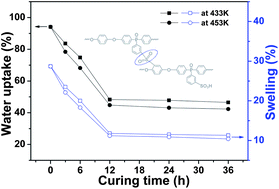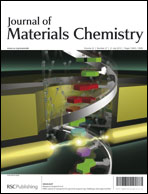High performance sulfonated poly(arylene ether phosphine oxide) membranes by self-protected cross-linking for fuel cells†
Abstract
This work investigated the thermal treatment of sulfonated poly(arylene ether phosphine oxide) membranes under vacuum without using any cross-linking agents or additives. During the thermal treatment, the sulfonic acid groups of the membranes acted as cross-linkable groups and reacted with the activated benzene rings in the membranes, resulting in self-cross-linking. Interestingly, the available degree of cross-linking of the membranes almost no longer increased with increasing time and temperature after the required thermal treatment because many sulfonic acid groups of the membranes could not be cross-linked due to steric hindrance and only functioned as a conducting group of


 Please wait while we load your content...
Please wait while we load your content...